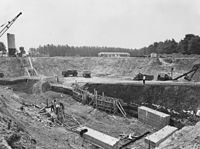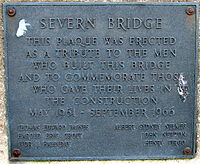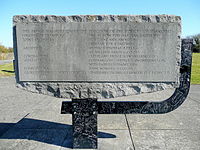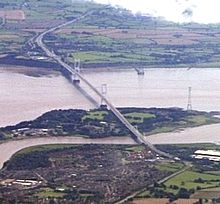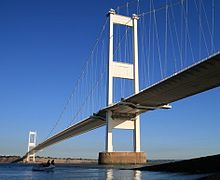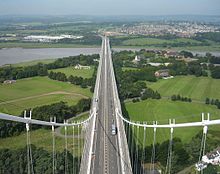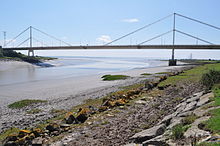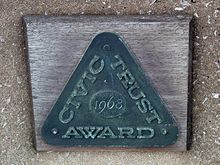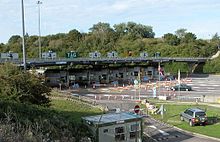
Severn Bridge
Background Information
This selection is made for schools by a children's charity read more. Child sponsorship helps children one by one http://www.sponsor-a-child.org.uk/.
| Severn Bridge | |
|---|---|
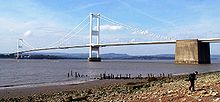 The Severn Bridge seen from the English side of the river. From 1966 to 1996, the bridge carried the M4 motorway. On completion of the Second Severn Crossing, the motorway from Olveston (England) to Magor (Wales) was renamed the M48. |
|
| Carries | 4-lane M48 motorway National Cycle Route 4 |
| Crosses | River Severn River Wye |
| Locale | South West England / South East Wales |
| Design | Suspension bridge |
| Total length | 0.99 mi (1.6 km) |
| Height | 445 ft (136 m) |
| Longest span | 3,240 ft (988 m) |
| Clearance below | 154 ft (47 m) |
| Constructed by | John Howard & Co., Sir William Arrol & Co., Cleveland Bridge & Engineering Company and Dorman Long |
| Opened | 8 September 1966 |
| Toll | Car: £6.20 Van: £12.40 HGV: £18.60 Motorcycle: free Disabled-badge holder: free |
| Coordinates | 51°36′32″N 2°38′18″W Coordinates: 51°36′32″N 2°38′18″W |
The Severn Bridge ( Welsh: Pont Hafren) is a motorway suspension bridge spanning the River Severn and River Wye between Aust, South Gloucestershire (just north of Bristol) in England, and Chepstow, Monmouthshire in South Wales, via Beachley, Gloucestershire, a peninsula between the two rivers. It is the original Severn road crossing between England and Wales and took five years to construct at a cost of £8 million. It replaced the Aust ferry.
The bridge was opened on 8 September 1966, by Queen Elizabeth II, who hailed it as the dawn of a new economic era for South Wales. The bridge was granted Grade I listed status on 26 November 1999.
History
The first proposal for a bridge across the Severn, approximately in the same location as that eventually constructed, was in 1824 by Thomas Telford, who had been asked to advise on how to improve mail coach services between London and Wales. No action was taken, and over the next few decades the railways became the dominant mode of long-distance travel, with the Severn Railway Bridge at Sharpness being opened in 1879 and the main line Severn Tunnel in 1886. However, the growth of road traffic in the early 20th century led to further calls for improvements, and in the early 1920s Chepstow Urban District Council convened a meeting of neighbouring local authorities to consider a Severn crossing to ease congestion and delays on the A48 passing through the town. In 1935 Gloucestershire and Monmouthshire County Councils jointly promoted a Parliamentary Bill to obtain powers to build the bridge over the estuary, with 75% of costs to be met by the Ministry of Transport from the Road Fund. However, the Bill was rejected by Parliament after opposition from the Great Western Railway Company.
After World War II, plans began to be made for a nationally funded network of trunk roads, including a Severn Bridge, for which the contract was awarded to Mott, Hay and Anderson, with Freeman Fox and Partners. The public inquiry into the scheme was held on 24 September 1946 at Bristol University. However, because Government funding was prioritised for the similar Forth Road Bridge (opened in 1964), construction of the Severn Bridge was not started until 1961: the UK government announced in 1962 that construction costs would be 'recovered' by means of a toll of 2s 6d (GBP 0.125) on all vehicle crossings, though walking or cycling across the bridge would be charge-free. The substructure was completed by contractors John Howard and Co in 1963. The superstructure contract was awarded to Associated Bridge Builders Ltd (a joint venture of Sir William Arrol & Co., Cleveland Bridge & Engineering Company and Dorman Long) in 1963, and completed in 1966.
Component structures
The Severn Bridge crossing consists of four structures, which, listed in order from England to Wales, are: the Aust Viaduct, Severn Bridge, Beachley Viaduct and Wye Bridge. The Severn Bridge and Aust Viaduct was granted Grade I listed status on 26 November 1999, while the Wye Bridge and Beachley Viaduct was granted Grade II listed status on 29 May 1998.
Aust Viaduct
The 514 ft (157 m) Aust Viaduct is a twin box girder structure with a concrete deck, which carries the roadway from the top of Aust Cliff to the first gravity anchorage of the old Severn Bridge. The roadway is then carried over the top of the concrete anchorage to the Severn Bridge.
Severn Bridge
The Severn Bridge is located close to the former Aust Ferry. The bridge is a suspension bridge of conventional design, with the deck supported by two main cables slung between two steel towers. In 1966 the cables supporting the bridge deck were spun from 18,000 miles (29,000 km) of wire. An unusual feature of the suspension cables carrying the deck is that they are not vertical, as for most suspension bridges, but rather arranged in a zig-zag fashion, with adjacent mounts closely spaced. The triangulation this offers is an attempt to reduce vibration, as is the prominent use of Stockbridge dampers on the cables. The bridge is 5,240 ft (1,600 m) long, consisting of a 3,240 ft (988 m) central span between the towers and the two 1,000 ft (305 m) side spans. The towers rise to 445 ft (136 m) above mean high water and are of hollow box construction. The deck is an orthotropic steel box girder of aerofoil shape with cantilevered cycle tracks and footway supported from the box. The shape of the bridge was determined by the designers Freeman, Fox and Partners following wind tunnel tests for the Forth Road Bridge, after the original wind tunnel model was accidentally destroyed. The sections of the deck were built at Fairfield-Mabey in Chepstow, and each 132 tonne section was then floated down the river before being hoisted into position.
Beachley Viaduct
The 2,444 ft (745 m) Beachley Viaduct is also of similar box girder construction as the Severn Bridge but is supported on steel trestles as it crosses the Beachley peninsula. The peninsula contains an army camp, which the bridge crosses.
Wye Bridge
The Wye Bridge is a 1,340 ft (408 m) long cable-stayed bridge, which crosses the border marked by the River Wye between England and Wales, 2 miles (3.2 km) south of Chepstow. It consists of a single large cable stayed section with two single-leg pylons supporting the bridge deck from the centre of the roadway. The deck is an orthotropic box girder similar to the Severn Bridge but has a different appearance as it has two sets of cable stays on each of two towers. Originally there was only one set of cable stays but these were replaced during the strengthening works. The Wye Bridge was built by Cleveland Bridge & Engineering Company.
Post-construction changes
In January 1977, it was announced that bridge traffic would be restricted to a single lane in each direction following the discovery of several weaknesses in the ten year old structure. The lane closures would last for several months.
The Severn Bridge crossing was strengthened and resurfaced in the late 1980s as the weight of traffic grew. The work included the strengthening of the Severn Bridge towers and deck, an extension to the existing Wye Bridge towers and the replacement of the original single stays with two stays. The open structure of the new stays is designed to facilitate maintenance. Most of the strengthening work was inside the deck box and towers and so is not visible. The surfacing is a 35 mm (1.4 in) thick layer of mastic asphalt over an acrylic waterproofing membrane.
Tolls
Shortly after the opening of the Severn Bridge, Anglo-Welsh poet Harri Webb wrote an Ode on the Severn Bridge:
- Two lands at last connected
- Across the waters wide,
- And all the tolls collected
- On the English side.
The toll is indeed collected on the English side, and only on vehicles travelling westwards from England to Wales, leading some people to describe it as a "tax on entering Wales", both in jest and also as a more serious anti-toll campaign. Originally, tolls were charged in both directions, but the arrangements were changed in the early 1990s to eliminate the need for a set of toll booths for each direction of travel and the potential for traffic waiting to pay the toll backing up onto the bridge itself.
In 1966, the toll for using the new motorway crossing was set at 2s 6d (post- decimalisation equivalent £0.125) for all vehicles apart from solo motorcycles which enjoyed a reduced toll of 1s (£0.05). For a small car the bridge toll represented a saving of 7s (£0.35) on the price, at that time 9s 6d (£0.475), of using the ferry crossing. By 1989, the toll had reached £2 each way for goods vehicle having an unladen weight exceeding 1.525 tonnes and passenger vehicles adapted to carry more than 16 passengers and £1 each way for other vehicles. Currency depreciation has been a feature of UK monetary policy in the intervening decades, and the RPI is a widely applied surrogate for the resulting impact of general price inflation: if the Severn toll had increased in line with general inflation since September 1966, when Queen Elizabeth II opened the bridge, the original value of £0.125 would have reached £2.02 each way in January 2010.
As of January 2013, the toll is £6.20 for a car, increasing to £18.60 for a heavy goods vehicle. Motorcycles and disabled badge holders are exempt from the tolls, although both must stop at the toll booths to have their eligibility confirmed, and also to allow the barrier to be raised. The tolls for the Second Severn Crossing are the same, although in that case, the tolls are collected on the Welsh side (although still for traffic entering Wales, not leaving it), sufficiently far from the bridge that even severe queueing doesn't reach it. A system known as the Severn TAG made by Amtech is also in operation, which allows drivers to pay electronically without having to stop at the toll booths. TAGs are available either on a per-trip or a seasonal basis, although only the latter attracts a discount.
Credit/ debit cards were not originally accepted on either bridge, but drivers who did not have the means to pay were able to get a bill from the toll operator and pay by post later. Card payment was made available in time for the 2010 Ryder Cup, however, users would be required to enter their PIN and cash was still the recommended payment method to avoid delays.
The cycle path and footpath, which run along either side of the roadway, may be used free of charge. Only the original bridge has such a public access.
Historic overview of the toll charges
| Date | Category 1 – passenger vehicles up to 9 seats | Category 2 – commercial vehicles up to 3,500 kg and buses up to 17 seats | Category 3 – commercial vehicles over 3,500 kg |
|---|---|---|---|
| 26 April 1992 | £2.80 | £5.60 | £8.40 |
| 1 January 1993 | £3.10 | £6.20 | £9.30 |
| 1 January 1994 | £3.40 | £6.80 | £10.10 |
| 1 January 1995 | £3.70 | £7.40 | £11.10 |
| 1 January 1996 | £3.80 | £7.70 | £11.50 |
| 1 January 1997 | £3.90 | £7.80 | £11.70 |
| 1 January 1998 | £4.00 | £8.10 | £12.10 |
| 1 January 1999 | £4.20 | £8.40 | £12.50 |
| 1 January 2000 | £4.20 | £8.50 | £12.70 |
| 1 January 2001 | £4.40 | £8.70 | £13.10 |
| 1 January 2002 | £4.40 | £8.90 | £13.30 |
| 1 January 2003 | £4.50 | £9.00 | £13.50 |
| 1 January 2004 | £4.60 | £9.30 | £13.90 |
| 1 January 2005 | £4.80 | £9.60 | £14.30 |
| 1 January 2006 | £4.90 | £9.80 | £14.70 |
| 1 January 2007 | £5.10 | £10.20 | £15.30 |
| 1 January 2008 | £5.30 | £10.60 | £15.90 |
| 1 January 2009 | £5.40 | £10.90 | £16.30 |
| 1 January 2010 | £5.50 | £10.90 | £16.40 |
| 1 January 2011 | £5.70 | £11.50 | £17.20 |
| 1 January 2012 | £6.00 | £12.10 | £18.10 |
| 1 January 2013 | £6.20 | £12.40 | £18.60 |
Ownership
Ownership and operation of the bridge passed to Severn River Crossing plc on 26 April 1992 as part of the deal to build the Second Severn Crossing.
As of November 2010, Severn River Crossing Plc was owned
- 35% John Laing, British developer infrastructure operator
- 35% Vinci, French concessions and construction company
- 15% Bank of America, American multinational banking and financial services corporation
- 15% Barclays Capital, British multinational investment bank
The company's 2011 annual report showed the same companies still owned, through subsidiary companies, all the issued ordinary share capital of the Plc.
Ownership of the bridge and the Second Severn Crossing will return to the UK government when the revenue required to build and maintain them, as defined in a Concession Agreement with the Secretary of State for Transport, has been collected. In 2010, the concession was expected to end in 2017. In 2012, changes were made to the agreement to reflect the effect of changes in VAT and Corporation Tax and the costs of installing credit card handling systems. The net effect was to increase the required revenue from £995.83 million to £1,028.91 million in 1989 prices.
40 year inspections
During its 40th year of operation, the bridge was inspected to check for corrosion of the suspension cables. According to the Highways Agency, the inspection concluded that the bridge needed restrictions on heavy goods vehicles. Such vehicles are now restricted to one lane on the bridge, with weight restriction signs in place. A system of installing a rubber casing on the cables with dry air circulation is to be used on the Forth Road Bridge and a similar system may be implemented on the Severn Bridge, in a move to halt the progress of the corrosion.
Simultaneous closures in 2009
On 6 February 2009, during a week of snowfall throughout Britain, both Severn bridges were closed simultaneously due to ice falling from the bridge structure and damaging vehicles. On 22 December 2009 both bridges were closed again for the same reason.
This was only the third time that both bridges have been closed together, the first being due to a chemical fire in Avonmouth some years earlier.
